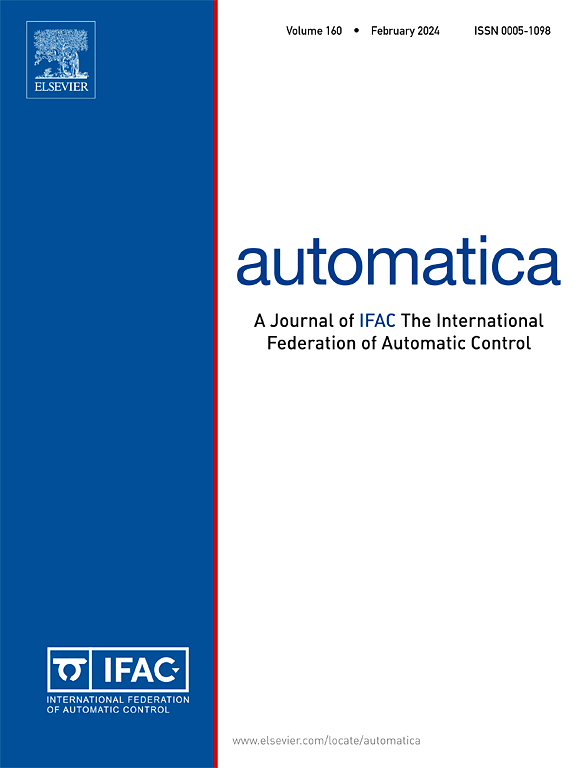Coevolutionary dynamics of multidimensional opinions over coopetitive influence networks
IF 4.8
2区 计算机科学
Q1 AUTOMATION & CONTROL SYSTEMS
引用次数: 0
Abstract
To better understand opinion dynamics on social networks, especially when antagonistic interactions exist, we propose a novel coevolution model of multidimensional opinions and coopetitive (cooperative–competitive) influence networks. In this model, agents update their opinions according to the designed multidimensional Altafini-type rule. Additionally, the asynchronous evolutionary dynamics of influence networks is formulated based on three well-established sociological mechanisms: symmetry, influence, and person-opinion homophily. Going beyond the limitations of existing models in explaining network structural evolution, we characterize the sign equilibria of the influence dynamics as equivalent to all possible fully connected structurally balanced configurations, and prove that the influence networks will almost surely converge to sign equilibria within finite time. Further, we claim convergence of the opinion dynamics model and systematically analyze the role of the set of logic matrices in determining the limiting opinion distribution. For irreducible logic matrices, agents’ opinions on each topic exhibit a bipartite consensus under conditions of structurally balanced logic matrices and no competing logical interdependencies. For reducible logic matrices, the scope of opinions on a topic within an open strongly connected component (SCC) is determined by that of the closed SCCs it connects to. Finally, we provide simulation examples to illustrate the theoretical results.
多维意见在竞争影响网络上的协同进化动力学
为了更好地理解社会网络上的意见动态,特别是当敌对互动存在时,我们提出了一个多维意见和合作(合作-竞争)影响网络的新型协同进化模型。在该模型中,智能体根据设计的多维altafini型规则更新意见。此外,影响网络的异步进化动力学是基于三种完善的社会学机制:对称性、影响力和个人意见同质性。突破了现有模型在解释网络结构演化方面的局限性,将影响动力学的符号均衡刻画为等价于所有可能的全连接结构平衡构型,并证明了影响网络在有限时间内几乎肯定会收敛到符号均衡。进一步,我们证明了意见动态模型的收敛性,并系统地分析了逻辑矩阵集在决定意见极限分布中的作用。对于不可约逻辑矩阵,当逻辑矩阵结构平衡且没有相互竞争的逻辑依赖关系时,智能体对每个主题的意见表现出二部共识。对于可约逻辑矩阵,在一个开放强连接分量(SCC)内,一个主题的意见范围由它所连接的闭连接分量的意见范围决定。最后,通过仿真实例对理论结果进行了说明。
本文章由计算机程序翻译,如有差异,请以英文原文为准。
求助全文
约1分钟内获得全文
求助全文
来源期刊

Automatica
工程技术-工程:电子与电气
CiteScore
10.70
自引率
7.80%
发文量
617
审稿时长
5 months
期刊介绍:
Automatica is a leading archival publication in the field of systems and control. The field encompasses today a broad set of areas and topics, and is thriving not only within itself but also in terms of its impact on other fields, such as communications, computers, biology, energy and economics. Since its inception in 1963, Automatica has kept abreast with the evolution of the field over the years, and has emerged as a leading publication driving the trends in the field.
After being founded in 1963, Automatica became a journal of the International Federation of Automatic Control (IFAC) in 1969. It features a characteristic blend of theoretical and applied papers of archival, lasting value, reporting cutting edge research results by authors across the globe. It features articles in distinct categories, including regular, brief and survey papers, technical communiqués, correspondence items, as well as reviews on published books of interest to the readership. It occasionally publishes special issues on emerging new topics or established mature topics of interest to a broad audience.
Automatica solicits original high-quality contributions in all the categories listed above, and in all areas of systems and control interpreted in a broad sense and evolving constantly. They may be submitted directly to a subject editor or to the Editor-in-Chief if not sure about the subject area. Editorial procedures in place assure careful, fair, and prompt handling of all submitted articles. Accepted papers appear in the journal in the shortest time feasible given production time constraints.
 求助内容:
求助内容: 应助结果提醒方式:
应助结果提醒方式:


